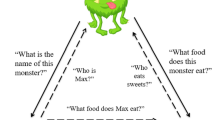Abstract
The present study evaluated the efficacy of a discrete-trial-training procedure to bring extended verbal behavior under the convergent control of audience and contextual variables during a show-and-tell activity. Three children with autism were exposed initially to a baseline condition in which they were presented with a preferred item and asked to tell the class about it. Following low rates of responding, a differential reinforcement procedure was implemented that reinforced extending the verbal utterance word length beyond baseline levels allowing for an appropriate display of “show-and-tell” behavior. The results show that the procedures were efficacious in application with three children with autism, providing a method that can be conducted in classroom settings to teach a complex form of verbal operant behavior.

Similar content being viewed by others
References
Dixon, M. R. Belisle, J,. Stanley, C. R., & Rowsey, K. (2018). Student outcomes after 1 year of front line staff implementation of the PEAK curriculum. Behavioral Interventions, https://doi.org/10.1002/bin.1516.
Dixon, M. R. (2014). PEAK relational training system: direct training module. Carbondale, IL: Shawnee Scientific Press.
Dixon, M. R., Small, S. L., & Rosales, R. (2007). Extended analysis of empirical citations with Skinner’s verbal behavior: 1984–2004. The Behavior Analyst, 30, 197–209.
Dixon, M. R., Belisle, J., Whiting, S. W., & Rowsey, K. E. (2014a). Normative sample of the PEAK relational training system: direct training module and subsequent comparisons to individuals with autism. Research in Autism Spectrum Disorders, 8, 1597–1606. https://doi.org/10.1016/j.rasd.2014.07.020.
Dixon, M. R., Whiting, S. W., Rowsey, K., & Belisle, J. (2014b). Assessing the relationship between intelligence and the PEAK relational training system. Research in Autism Spectrum Disorders, 8, 1208–1213. https://doi.org/10.1016/j.rasd.2014.05.005.
Dixon, M. R., Belisle, J., Stanley, C., Rowsey, K., Daar, J. H., & Szekely, S. (2015). Toward a behavior analysis of complex language for children with autism: evaluating the relationship between PEAK and the VB-MAPP. Journal of Developmental and Physical Disabilities, 27, 223–233. https://doi.org/10.1007/s10882-014-9410-4.
Dixon, M. R., Belisle, J., McKeel, A., Whiting, S., Speelman, R., Daar, J. H., & Rowsey, K. (2017). An internal and critical review of the PEAK relational training system for children with autism and related intellectual disabilities: 2014–2017. The Behavior Analyst, 40, 493–521.
Greer, R. D., & Speckman, J. (2010). The integration of speaker and listener responses: a theory of verbal development. The Psychological Record, 59, 449–488.
Ingvarsson, E. T., Tiger, J. H., Hanley, G. P., & Stephenson, K. M. (2007). An evaluation of intraverbal training to generate socially appropriate responses to novel questions. Journal of Applied Behavior Analysis, 40, 411–429.
McKeel, A. N., Dixon, M. R., Daar, J. H., Rowsey, K. E., & Szekely, S. (2015). Evaluating the efficacy of the PEAK Relational Training System using a randomized controlled trial of children with autism. Journal of Behavioral Education, 24, 230–241.
Michael, J., Palmer, D. C., & Sundberg, M. L. (2011). The multiple control of verbal behavior. The Analysis of Verbal Behavior, 27, 3–22.
Rowsey, K. E., Belisle, J., & Dixon, M. R. (2015). Principal component analysis of the PEAK relational training system. Journal of Developmental and Physical Disabilities, 27, 15–23. https://doi.org/10.1007/s10882-014-9398-9.
Skinner, B. F. (1957). Verbal behavior. Englewood Cliffs, NJ: Prentice Hall.
Author information
Authors and Affiliations
Corresponding author
Ethics declarations
Ethical Approval
All procedures performed in this study which involved human participants was in accordance with the ethical standards of the institution and/or national research committee and with the 1964 Helsinki declaration and its later amendments or comparable ethical standards.
Informed Consent
Informed consent was obtained for participation in this research.
Disclosure
First author receives small royalties from sales of the PEAK curriculum.
Rights and permissions
About this article
Cite this article
Dixon, M.R., Blevins, A., Belisle, J. et al. Teaching Children with Autism Extended Verbal Utterances Under Audience Control in the Context of Show-and-Tell. Behav Analysis Practice 12, 194–198 (2019). https://doi.org/10.1007/s40617-018-0250-z
Published:
Issue Date:
DOI: https://doi.org/10.1007/s40617-018-0250-z




